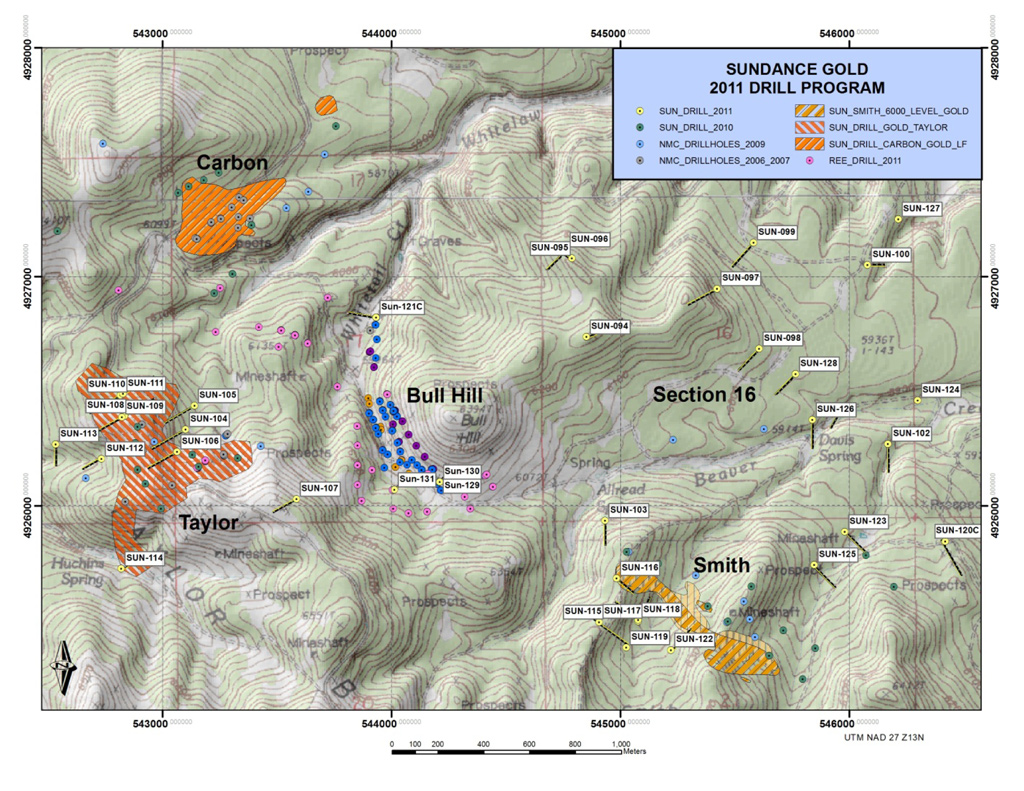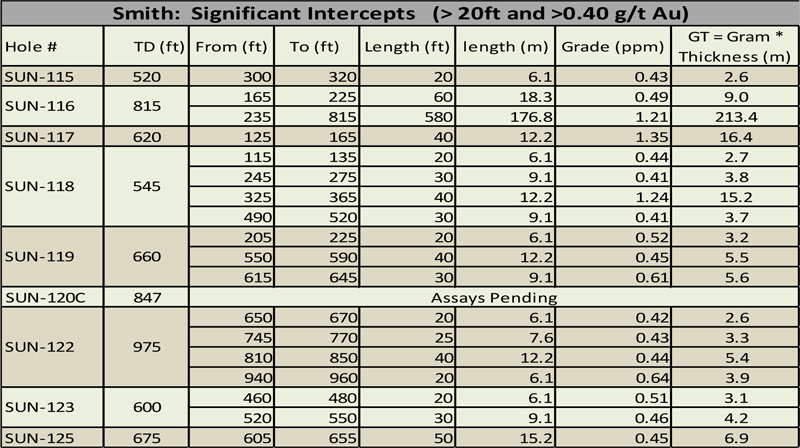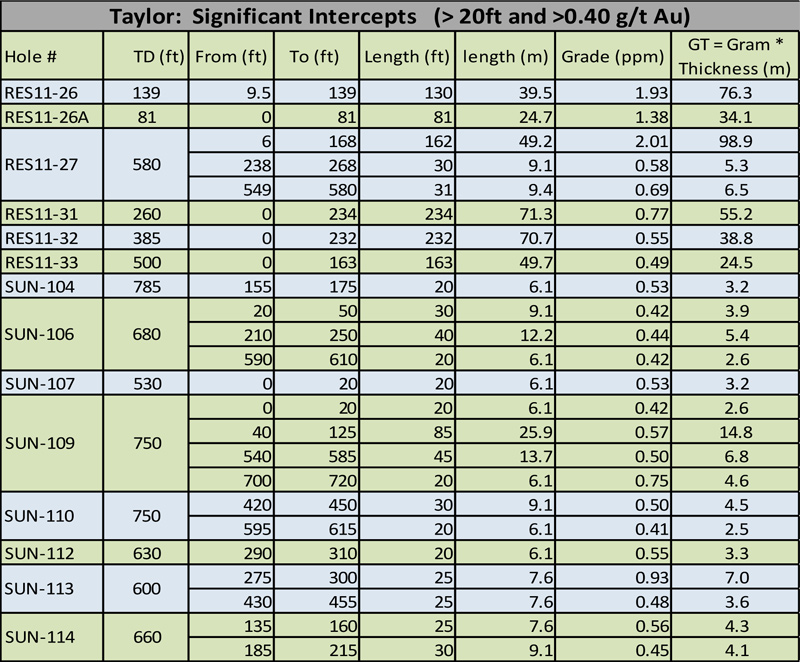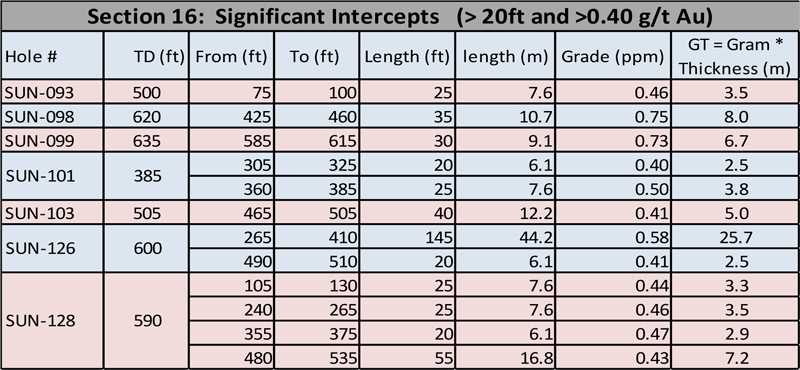Vancouver B.C. - Rare Element Resources Ltd. (NYSE Amex: REE; TSX: RES) announces assay results from 34 rotary (reverse circulation) and two core holes drilled at the Sundance Gold Project, Wyoming (drill holes SUN-093 to SUN-128).
- Drill hole SUN-116 with 1.21 g/t over 176.8m including 4.5 g/t Au over 24.4m
- Drill hole RES11-31 with 0.77 g/t over 71.3m
Vancouver B.C. - Rare Element Resources Ltd. (NYSE Amex: REE; TSX: RES) announces assay results from 34 rotary (reverse circulation) and two core holes drilled at the Sundance Gold Project, Wyoming (drill holes SUN-093 to SUN-128). A total of 36 drill holes containing 22,930 feet (6,989 m) were drilled during 2011, including 20 holes on near-surface targets within oxide zone mineralization at the Taylor and Smith target areas and 15 holes (7,925 ft/2,416m) of condemnation drilling in a proposed tailings disposal site in Section 16 (Figure 1). Additionally, six core holes (1,945 feet/593m), were drilled in the Taylor area to define a zone of coincident heavy rare earth element (HREE) and gold mineralization. Gold exploration activity during 2011 was focused on: 1) step-off drilling from known mineralization, 2) new target area testing, and 3) condemnation of an area proposed for tailings disposal. This press release covers the results of all the gold exploration drilling in 2011 while previous drilling results were reported in press releases October 27, 2011 and December 5, 2011.
John T. Ray, Exploration Manager for the Company stated, "SUN-116 located at the Smith target area has the highest gold grades and thickest interval of plus 1 g/t Au ever reported for the entire district and is open in two directions. We are excited about the discovery of this new prospect and anticipate determining the size and orientation of its high-grade nucleus. Most of the holes in the East Taylor area have significant near-surface intercepts of +1 g/t Au. Our goal of the 2011 drilling to find areas of higher grade gold mineralization was achieved. Over the next few years, additional drilling will be needed to determine the extent of this mineralization."
Figure 1: Plan map showing the location of the Smith, Carbon, Taylor, and Section 16 gold target areas within part of Rare Element Resources' Bear Lodge/Sundance Property. The gold targets surround the Bull Hill REE deposit. The drill hole collars from the 2011 program are shown in yellow. Drill-indicated gold-mineralized areas that contain greater than 300 ppb (>0.3 g/t) gold for each target area are shown as ruled polygons.

Smith Gold Target
In 2010, drill hole SUN-060 intersected 0.89 g/t Au over 85.5m, including 1.3 g/t over 44.2m along the strike of the main pseudoleucite body in veined phonolite wall rock. SUN-116 is a follow-up hole situated 100m west of SUN-060 and oriented to intersect a mineralized trend believed to be perpendicular to the main zone. Assays from SUN-116 returned 1.21 g/t Au over 176.8m, including 4.5 g/t Au over 24.4m, and penetrated similar host rock of K-feldspar veined phonolite. This represents, by far, the highest grade and thickest gold drill intercept in the fifty year exploration history of the entire Bear Lodge Alkaline Complex. Drill hole SUN-117, collared west of SUN-116, contains an intercept of 1.35 g/t Au and SUN-118 has 1.24 g/t Au each over widths of 12.2 m. Further to the west, SUN-119 has significant intercepts exceeding 0.5 g/t Au. These data are beginning to define a new target area of noteworthy grade adjacent and perpendicular to the main Smith deposit. The occurrence of open-space K-feldspar veining and the higher grade intervals (up to 11.4 g/t Au) within this new zone are suggestive of a feeder structure. A half-kilometer east of the main Smith deposit, drill holes SUN-123 and SUN-125 are follow-up tests of 2010 drill hole SUN-069, which contains an intercept of 0.49 g/t Au over 27.4m, coincident with a northeast-trending valley structure. Similar grades over narrower intervals in SUN-123 and SUN-125 suggest potential for a new area of low-grade gold mineralization. Assays from core hole SUN-120C are pending. Eight rotary holes containing 5,410 feet (1,649m) were drilled to test areas adjacent to and outboard of the Smith gold resource area (SUN-115 through SUN-119, SUN-122, SUN-123 and SUN-125). Gold mineralization at Smith is hosted by a steeply-dipping, brecciated pseudoleucite dike that strikes northwesterly. The mineralization extends from the surface to a depth of 1,000 feet (300m) and remains open at depth.
Table 1: Selected significant gold intercepts from the 2011 drilling program at the Smith target area, Sundance Project, Wyoming.

Taylor Gold Target
Representative grades within the mineralized plume at Taylor range from 0.42-0.67 g/t Au over thicknesses of 56 to 192m. In 2010, SUN-090 penetrated a higher grade portion of the plume that assayed 1.34 g/t Au over 62.5m with coincident HREE-enriched mineralization. Eleven rotary holes (7,550ft/2,301m) were drilled at Taylor in 2011 to define a potential minable resource (SUN-104 through SUN-114). The gold mineralization at Taylor is contained within a plume-like mass hosted by Tertiary alkaline intrusions and Cambro-Ordovician sandstones of the Deadwood Formation. The mineralization generally extends from the surface to a depth of about 400 feet (125m). In 2011, core drilling was conducted in the vicinity of rotary hole SUN-090 to determine controls on the HREE-enrichment and coincident gold mineralization. Results included 1.93 g/t Au over 39.5m, 1.38 g/t Au over 24.7m, and 2.01 g/t Au over 49.2m, respectively (Table 2). In the same cluster and 30m to the east, RES11-31 assayed 0.77 g/t Au over 71.3m from surface to a depth of 234 feet, RES11-32 contains 0.55 g/t Au over 70.7m from surface to a depth of 232 feet, and RES11-33 has 0.49 g/t Au over 49.7m from the surface to a depth of 163 feet. These results indicate an approximate width of 120m for this easterly-trending zone of gold mineralization and HREE enrichment. Gold assay results are pending for RES11-28.
Rotary drill results from the Taylor area are also shown in Table 2. Drill holes SUN-109 and SUN-110 identify the continuation of anomalous gold mineralization to the northwest on the west side of Taylor Ridge, whereas drill holes SUN-104, SUN-105, SUN-108, and SUN-111 effectively cut off gold mineralization on the east side of Taylor Ridge. The gold intercepts in SUN-113, including 0.93 g/t Au over 7.6m, are associated with a cylindrical resistivity anomaly and show potential for the development of another satellite deposit on the west side of the ridge. Drill hole SUN-114 failed to reach its target depth to test historic gold intercepts, owing to poor ground conditions.
Table 2: Selected significant gold intercepts from the 2011 drilling program at the Taylor target area, Sundance Project, Wyoming.

Section 16 Area
Section 16 is an area east of Bull Hill that is under consideration for a stockpile and waste facility for the proposed REE mine. During 2011, 15 rotary holes aggregating 7,533ft/2,296m were drilled to assess the REE and gold mineralization potential. Limited drilling of four holes on the west side of Section 16 suggests minimal exploration potential manifested in drill hole SUN-093 by an isolated, narrow gold zone assaying 0.46 g/t Au over 7.6m and thin and sparse FMR (Iron-Manganese-Rare Earth) dikes. Most of the remaining holes were drilled in the central portion of the section (Figure 1). Although no significant REE mineralization was encountered, anomalous gold mineralization is identified in four holes. Drill holes SUN-098, SUN-101, SUN-126, and SUN-128 (Table 3) contribute to the definition of an anomalous zone that is subject to additional evaluation in 2012.
Table 3: Selected significant gold intercepts from the 2011 drilling program at the Section 16 area, Sundance Project, Wyoming.

Rare Element Resources Ltd (TSX: RES & AMEX: REE) is a publicly traded mineral resource company focused on exploration and development of rare-earth elements and gold on the Bear Lodge property.
ON BEHALF OF MANAGEMENT
James G. Clark, Ph.D., Vice President Exploration
For information, refer to the Company's website at www.rareelementresources.com or contact:
Anne Hite, Director of Investor Relations, (720) 278-2466 or ahite@rarelementresources.com
Donald E. Ranta, PhD, PGeo, serves the Board of Directors of the Company as an internal, technically Qualified Person. Technical information in this news release has been reviewed by Dr. Ranta and has been prepared in accordance with Canadian regulatory requirements that are set out in National Instrument 43-101. This news release was prepared by Company management, who take full responsibility for content. Neither TSX Exchange nor its Regulation Services Provider (as that term is defined in the policies of the TSX Exchange) accepts responsibility for the adequacy or accuracy of this release.
Forward-Looking Statements
Except for statements of historical fact, certain information contained herein constitutes forward-looking statements. Forward looking statements are usually identified by our use of certain terminology, including "will", "believes", "may", "expects", "should", "seeks", "anticipates", "has potential to", or "intends" or by discussions of strategy or intentions. Such forward-looking statements involve known and unknown risks, uncertainties and other factors which may cause our actual results or achievements to be materially different from any future results or achievements expressed or implied by such forward-looking statements. Forward-looking statements are statements that are not historical facts, and include but are not limited to, statements regarding our expectations regarding future mineral resource estimates; our plans, objectives and expectations with respect to the Bear Lodge Project; general industry and macroeconomic growth rates and statements regarding future performance.
Forward-looking statements used in this discussion are subject to various risks and uncertainties, most of which are difficult to predict and generally beyond the control of the Company. Forward-looking statements in this document are not a prediction of future events or circumstances, and those future events or circumstances may not occur. If risks or uncertainties materialize, or if underlying assumptions prove incorrect, our actual results may vary materially from those expected, estimated or projected. Important factors than can cause the Company's actual results to differ materially from those anticipated in the forward-looking statements include risks associated with commodity prices, exploration results, governmental and environmental regulations, permitting, licensing and approval processes for our operations and other factors described under the heading "Risk Factors" in our Annual Report on Form 10-K for the year ended June 30, 2011, filed with the U.S. Securities and Exchange Commission ("SEC") as updated by our subsequent filings with the SEC. Given these uncertainties, users of the information included herein, including investors and prospective investors, are cautioned not to place undue reliance on such forward-looking statements. The Company undertakes no obligation to update any forward-looking statements made in this press release to reflect future events or developments, except as required by U.S. and Canadian securities laws.